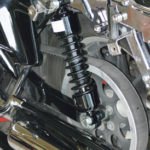PSI 440 Series Rear Shocks
Progressive Suspension Inc.
$534.95 (as tested)
www.progressivesuspension.com
877.690.7411
For more than 30 years I campaigned a rigid frame Shovelhead across Texas and the greater Southwest. I grew so accustomed to dodging potholes and bracing myself for sudden impacts that I’d almost forgotten there was an alternative. On one occasion I borrowed an associate’s swingarm-equipped bike and, even though the bike’s rear suspension was almost totally worn out, it was still such an improvement over my hardtail that I tagged my loaner the “Blue Sofa.” Fast forward to 2003, when I purchased a new Road King—ahhh, the luxury of an air-assisted, sprung butt section. (Don’t fret—I still own the Shovel and it’s still a rigid—apparently senility allows Old Farts to believe they are still Young Guns.)
Around the 50,000-mile mark, the Road King’s ride seemed to be getting rough to the point of causing me to once again become pothole wary. Like a fool, I unwisely surmised it probably wasn’t the unit’s fault but most likely my increasing age and the fact that I’d already put my kidneys through a quarter century of hell. So I checked and double-checked the air pressure to hopefully alleviate the problem. But with the stock Harley air shocks, unless you use a no-loss air gauge and are careful in the manner of equipment used to inflate them, you can easily blow the seals, rendering them useless. My concerns were confirmed during an extended road trip with a petite riding companion who complained of a crappy ride. So maybe it wasn’t the fact that I was nearing AARP eligibility. Apparently it was time for some replacements—and an upgrade if possible.
Not having a vast knowledge of rear suspension systems, I decided to tap the wisdom of someone in the know. Progressive Suspension Inc. has been refining their products to satisfy the needs of bikers for more than 25 years. They are one of the most well-known and respected manufacturers of aftermarket motorcycle suspension systems in the world, and the largest in the United States. They supply suspension components to several domestic OE customers like American IronHorse and Motor Trike. I pinned down their director of marketing, David Zemla, who was surprised that I’d gotten as many miles out of my stock shocks as I had.
He then proceeded to give me a quick lesson in Suspension 101. That’s when I learned that the Progressive Suspension name was not chosen simply because they were ahead of other companies’ technologies. It has to do with the manner in which a coil spring is manufactured. A wound steel spring is defined by its rate, a measurement of the force required to compress the spring. This measurement is expressed in pounds per inch. As an example, a straight or linear-rate spring rated at 100 lbs/inch will require a force of 100 pounds to compress it one inch. Each subsequent inch of compression requires an additional 100 pounds of pressure. But a “progressive”-rate spring allows a single spring to exhibit multiple rates. This is accomplished by varying the spacing of the spring coils. The initial inch of compression may require 100 pounds of force, but the second inch would require more than an additional 100 pounds, and the third inch would require still more. The harder progressive-rate springs are pushed, the stiffer they become (kinda like some relationships I’ve endured). The result is a spring that is flexible enough to handle small road bumps but also capable of absorbing a major jolt.
Then David asked, “So, you want pretty or do you want a great ride?”
I responded simply, “I can’t think of anything prettier than a great ride.”
He smiled and pointed me in the direction of the PSI 440 Series. This is the same model that David runs on his Road King and it’s hard to get a better recommendation than that. The 440 Series features their road-proven progressive wound springs encasing a gas-charged damper labeled Inertia Active System, or IAS. This damper uses an oil reservoir along with heat-tolerant nitrogen under high pressure to assist in the dampening and prevent any pogo effect. An internal inertia valve separates the soft (wheel) rebound circuit from the hard (chassis) circuit resulting in a shock that has superior response to sudden impacts.
I asked David the reasoning behind replacing the stock air shocks with spring shocks. Seems their research has determined that the FLH’s shock-to-swingarm design (locating the lower shock mount behind the axle) results in poor lever geometry. Since air shocks use large seals, this configuration causes excessive “stiction,” which makes the shock assembly resistant to small movements and delays reaction time. Steel spring shocks have smaller seals that allow for a smoother range of movement and a more efficient ride. Since I was pleased with my current seat height, the 440- 4002 model I chose matched the stock-length shocks at 13″ (available lengths range from 11.5″ to 13.5″). They have 3.125″ of travel with a progressive spring rate of 90/130 lbs.
Installation is painless. The two most difficult parts are jacking the bike off the ground to relieve pressure from the swingarm and tracking down the knothead who borrowed your torque wrench. Progressive provides a universal mounting kit (this particular shock has several varied model fitments) that includes shouldered sleeves, spacers and washers. The stock bolting is retained. Installation requires leaving one existing shock in place while bolting on the first new 440 to keep the swingarm and wheel assembly from falling out of place. But once the bike is in the air, even the most anal of shade-tree mechanics should be able to complete the job in less than 20 minutes.
All of Progressive Suspension’s rear shocks are preload adjustable to allow easy tuning of the system to accommodate a passenger or touring gear. In the 440 Series, this feature is actuated by twisting the top retaining cap in a downward spiral and compressing the spring. A series of concentric ring indictors on the main body allows you to make certain both shocks are adjusted equally. Although this procedure is easiest to perform with a preload wrench (available from PSI), I didn’t have any problems making the adjustment with my bare hands, although I didn’t have to run the cap down very far to find my personal selection. After a couple of trial runs, I settled on ring #2 for the best around-the-town bump prevention. I click it down an additional notch when traveling long distance with a load of camera and camping gear.
The ride the 440 Series delivers is superior to the stock H-D system and makes this a project to consider even before you wear out your original equipment. Not only is the suspension action great but the handling also improves, with better tracking and less drift during cornering. Coming back from Sturgis this year, I took a detour through Rocky Mountain National Park, and while the beautiful Trail Ridge Road had me jumping over the Continental Divide, it also had me jumping off the asphalt and through several miles of gravel and washouts. Fully packed for a three-week trip, the heavily loaded Road King gobbled the gravel with the new 440 Series shocks performing admirably without a wince. PSI, my kidneys salute you.
The 440 Series comes with top and bottom machined aluminum end caps and is available in four different finish options: all chrome, black chrome caps with black springs, polished caps with chrome springs, and black powder coated caps with black springs. Since it’s all about the ride, I went the economical route—black on black. The 440 Series is also available in a Heavy-Duty Application that is recommended for bikes that are operated at or near the manufacturer’s maximum load rating over 50 percent of the time, and the IAS dampers are covered by a limited lifetime warranty.



















